Hong Kong Monetary Authority Annual Report 1997
ECONOMIC AND BANKING ENVIRONMENT
The Hong Kong economy enjoyed vigorous growth in the first half of 1997, after a moderate recovery in 1996. The regional financial shock hit the economy in the second half, with domestic demand dampened by higher interest rates and a sharp decline in asset prices. Nevertheless, with sound fundamentals, Hong Kong is expected to recover gradually as the regional economies consolidate and stabilize during 1998. Indeed, as of March 1998, there are already some signs that the region is beginning to regain investor confidence.
ECONOMY IN REVIEW
After a robust growth of 6.4% in the first half of 1997, the Hong Kong economy experienced a slow-down in the second half as the Asian financial turmoil spread. While construction activities slowed, consumer spending dropped in response to higher interest rates and falling asset prices. At the same time, exports grew at a slow pace, while tourist earnings were hit by a slump in tourist arrival. As a result, the economic expansion in the second half slowed to about 4%. For 1997 as a whole, real GDP is estimated to have grown by 5.2% (Table 1), slightly above the trend growth of 5%.
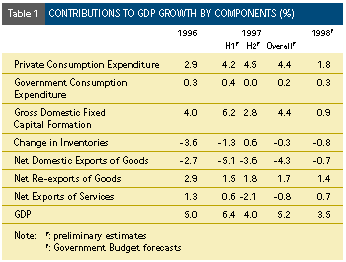
Consumer price inflation continued its downward trend in 1997, with the rise in Composite CPI further easing to 5.8%, from 6.3% in the previous year. Prices of tradable goods were largely contained by a strong Hong Kong dollar, weak consumption demand and low inflation in Hong Kong's trading partners.
After rising markedly in the first half, asset prices fell sharply in the fourth quarter, as interest rates rose sharply on tightened liquidity. Domestic credit expanded rapidly by an annual rate of 22.7% in the first three quarters of the year, but contracted in the fourth quarter as banks adopted a more cautious lending stance in the face of the financial turbulence.
Reflecting a slow-down in economic activity in the latter part of the year, money supply contracted in the fourth quarter, after expanding rapidly in the first three quarters. For the year as a whole, broad money supply, as measured by Hong Kong dollar M3, registered a moderate growth of 9.9%, compared with an increase of 18.9% in the previous year. On an average annual basis, it expanded by 19%, faster than an average increase of 15.1% in 1996 and the nominal GDP growth of 11.3%.
On the fiscal side, the financial year 1997/98 registered a substantial surplus of $77.0 bn or 5.8% of GDP ($25.7 bn surplus or 2.2% of GDP in 1996/97). A smaller surplus of $10.7 bn is budgeted for the financial year 1998/99. Continued fiscal discipline has restrained monetary expansion and helped contain inflation.
PRIVATE CONSUMPTION AND INVESTMENT MODERATED
Following a recovery in 1996, private consumption expanded strongly in the first half of 1997, led by increases in the consumption of durables, in particular motor vehicles (Chart 1). However, in the second half, consumer confidence fell, with retail sales slowing through the third quarter and falling by 4.8% in real terms in the fourth quarter compared with a year ago. For 1997 as a whole, private consumption grew by 7.3%, still faster than the 4.8% increase in 1996.
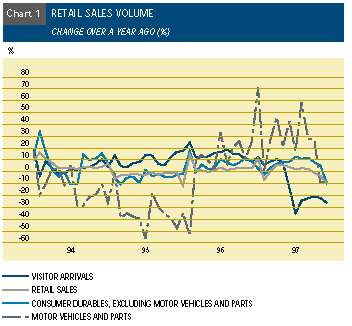
Investment in building and construction grew by 2.3% in 1997, after expanding by 7.4% in 1996. Public sector investment continued to consolidate in 1997, with the gradual completion of the Airport Core Programme. By contrast, private sector construction boosted by the buoyant property market, expanded robustly in the first three quarters of 1997, before slowing towards the fourth quarter as interest rates rose (Chart 2).
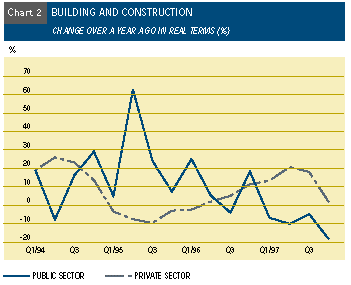
IMPORT GROWTH OUTPACED EXPORTS
Export performance improved during the course of 1997, with total exports growing by 6.1%, against 4.8% in 1996. Of the total, domestic exports grew by 2% while re-exports grew by 6.8%.
The overall performance in the export sector was affected by increasing competition from other developing countries, weak import demand in some of Hong Kong's major overseas markets and the strength of the US dollar against most major currencies.
On the other hand, with a revival in retained imports, particularly capital and consumer goods, import growth picked up to 7.1% in 1997, from 4.3% in 1996. For 1997 as a whole, the visible trade deficit widened to $163.5 bn (10.1% of total imports), from $141.9 bn (9.2% of total imports) in 1996. However, with exports growing faster than imports during the latter part of the year, the visible trade deficit then narrowed somewhat. In the fourth quarter, the visible trade deficit shrank to 7.7% of imports, from 9.1% in the same period a year earlier.
Exports of services slowed in 1997, along with a sharp decline in tourism revenue, while imports of services continued to increase. Nevertheless, exports of other services, in particular trade-related services, rose further in 1997. As a whole, invisible trade registered a surplus of $112.5 bn in 1997, resulting in a deficit of $51.0 bn in the overall trade account.
LABOUR MARKET TIGHTENED
The job market tightened in the first three quarters of 1997, with the unemployment rate declining steadily from 2.5% in the first quarter to 2.2% in the third quarter. In line with labour market conditions, earnings as measured by payroll per person engaged and the wage index picked up significantly by 4.1% and 1.7% in real terms respectively during the period.
However, towards the end of the year, the labour market showed signs of easing. The gap between the growth of total employment and labour force narrowed significantly, while the unemployment rate rose to 2.5% in the fourth quarter (Chart 3). Employment in construction, manufacturing, retail, restaurants/hotels and transport sectors was hard hit by the slow-down in domestic demand and the tourism industry. The earnings and wage growth in the fourth quarter slowed down as a result.
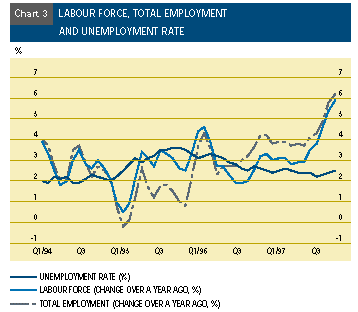
INFLATION EASED FURTHERN
Consumer price inflation, as measured by Composite CPI, slowed further to 5.8% in 1997, from 6.3% in 1996, the lowest in the past decade. Year-on-year growth in Composite CPI slowed to 5.2% by December. Domestically, steady wages and easing rents, as well as moderating consumer spending helped alleviate the inflationary pressure. Externally, prices of tradable goods were largely contained by a strong Hong Kong dollar and lower inflation in Hong Kong's major trading partners, particularly the mainland of China. Over the year, import prices declined by 2.3%, against a fall of 1.3% in 1996.
A SHARP TURN IN ASSET PRICES
Asset markets were extremely buoyant in the first seven months of 1997, supported by the smooth political transition and optimism about Hong Kong's economic future. The Hang Seng Index kept hitting new highs as new share floatations were heavily subscribed. During the period, the Hang Seng Index soared by 21.7%, with daily turnover averaging $13.6 bn, compared with $5.7 bn in 1996. Likewise, property prices also rose markedly, up by 32.9% in the first two quarters of 1997.
However, as the Asian currency turmoil spread, share prices fell sharply from the historic high of 16,820 on 7 August. Following the plunge in worldwide stock markets, the Hang Seng Index tumbled on 28 October by 1,722 points to 8,776, its lowest level for two-and- a-half years, and was down by 47.8% from its all-time high.
The stock market bounced back fairly rapidly, recovering 22.2% from its trough on 28 October to close the year at 10,723. On the whole, in terms of US dollar, the loss in Hong Kong's equity markets was amongst the least in the Asian economies (Chart 4). By the end of 1997, Hong Kong shares were traded at about 12 times earnings, while the S&P's 500 was at around 24 times.
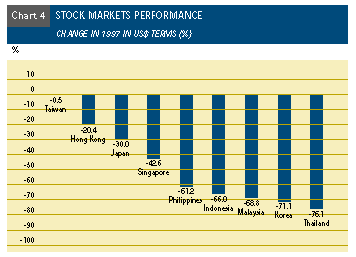
The property market also took a sharp turn in the fourth quarter of the year, as market sentiment turned negative. Tighter liquidity and sluggish demand from home buyers pushed residential property prices down by 20% to 30%. With the sharp fall in prices, housing has become more affordable than a year earlier.
MONETARY SITUATION
A STABLE HONG KONG DOLLAR
Exchange rate stability under the linked exchange rate system is the primary monetary policy objective of the HKMA. The Hong Kong Special Administrative Region (HKSAR) Government is fully committed to the maintenance of the linked exchange rate system. The robustness of the link has been underpinned by sound economic fundamentals, characterized by substantial foreign exchange reserves, strong fiscal discipline, a healthy banking system as well as an advanced financial infrastructure, including the region's first RTGS system with DvP linkage to the debt securities clearing system.
Notwithstanding the Asian currency turmoil, the exchange rate of the Hong Kong dollar remained remarkably stable against the US dollar during 1997. Although it came under pressure several times in the second half of 1997, the Hong Kong dollar remained intact (Chart 5), moving largely within a narrow range of 7.73 to 7.75. Along with the appreciation of the US dollar against other major currencies in the international currency markets, the overall exchange value of the Hong Kong dollar, as measured by the trade weighted effective exchange rate index (EERI), rose from 125.2 at the beginning of 1997 to 137.9 at the end of the year.
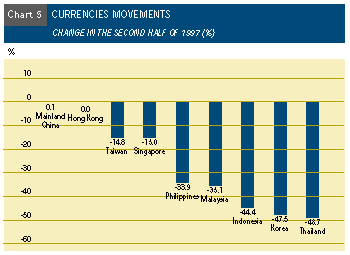
LOCAL INTEREST RATES ROSE
Following the 25 bp increase in Fed funds rate in the US on 26 March, local short-corresponding term interest rates rose by the same margin. Since then, US interest rates have remained steady while local interest rates rose significantly after the October currency shock.
The 3-month Hong Kong Interbank Offer Rate (HIBOR) rose from around 6.4% in July 1997 to over 9% at the end of 1997, and interest rates for time deposits were bid up to around 8.5%. As the cost of funds increased, mortgage rates rose markedly by about 100 bp to 125 bp from their levels in October, reversing the downtrend in the first three quarters of the year. In response to higher interbank rates and funding costs, leading banks in Hong Kong raised the best lending rate (BLR) twice, by a total of 150 bp on 24 October 1997 and 12 January 1998, to 10.25%. The HKAB also raised the savings deposit rate twice by the same magnitude. To accommodate the increased volatility in the overnight interbank rate, the bid and offer rates of the Liquidity Adjustment Facility (LAF) were adjusted to 4% and 7% respectively on 25 October, so that the width of the LAF corridor widened to 300 bp.
THE ASIAN PREMIUM
As local interest rates rose, the differential between Hong Kong dollar interest rates and US dollar interest rates widened, reflecting the perceived "Asian risk premium". For instance, the differential between the 3-month HIBOR and the Euro-dollar deposit rate rose to 344 bp at the end of the year, compared to virtual parity a year earlier. The differential between long-term interest rates also increased. The spread between 5-year Exchange Fund Notes and the corresponding US Treasuries, for instance, rose from 49 bp at end-1996 to 356 bp at end-1997. These spreads are expected to narrow when financial markets in the region stabilize.
MONEY SUPPLY GROWTH SLOWED
Following the strong expansion in the first three quarters, the growth in money supply slowed sharply in the fourth quarter, as domestic credit contracted along with the consolidation in local economic and asset market activities. Reflecting the slow-down in credit expansion in the last quarter of the year, Hong Kong dollar M1 fell by 7.8% in the fourth quarter, after increasing by 2.9% in the first three quarters. Likewise, Hong Kong dollar M2 and Hong Kong dollar M3 also declined by 3.4%, following a 13.7% growth during corresponding periods. For the year as a whole, broad money supply, as measured by Hong Kong dollar M3, grew by 9.9%, compared with an increase of 18.9% in 1996. On an average annual basis, it expanded by 19%, faster than an average rise of 15.1% in 1996 and nominal GDP growth of 11.3%.
NOTES AND COINS
As at the end of 1997, the outstanding total value of banknotes issued by the note issuing banks was $87,015 mn, an increase of 5.4% from a year earlier. As at the end of 1997, the total value of coins issued was $5,177 mn (excluding commemorative gold coins and coin sets), an increase of 24.5% from a year earlier (Charts 6, 7, 8, 9 and 10).
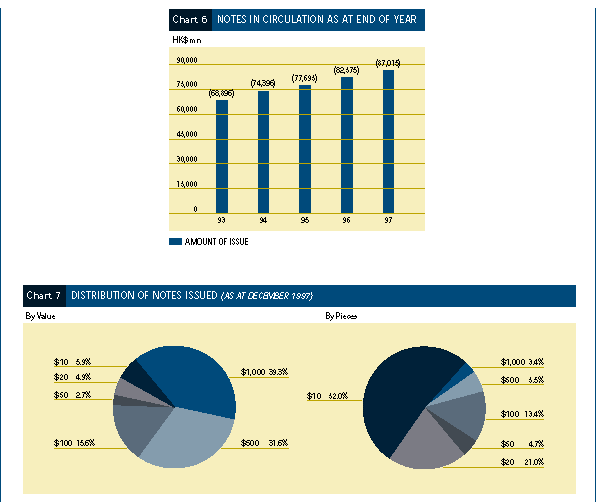
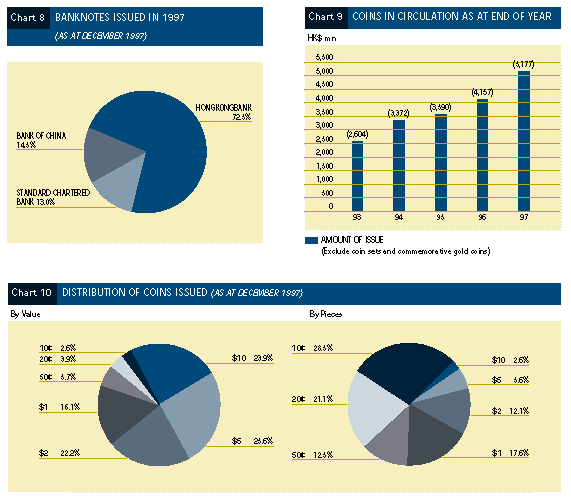
COIN SHORTAGE
The resumption of sovereignty by China on 1 July 1997 triggered a fever for collecting commemorative souvenirs. Queen's Head coins were widely sought after and an estimated 800 mn pieces of these coins still in active circulation in mid-1997 disappeared within a few months into personal collections and souvenir shops in Hong Kong and the mainland of China. These 800 mn pieces were replaced by year-end with newly minted Bauhinia design coins. The volume of new coins injected represented three times the normal annual demand for new coins.
Despite the record minting of new coins, the sharp demand from collection of the 1997 coins and souvenirs created a coin shortage which posed great inconvenience to the public. In 1998, a total of 900 mn pieces of new coins have been ordered to meet the public demand. The HKMA is fully committed to increasing the production and distribution of new coins until the situation is fully resolved.
COIN REPLACEMENT PROGRAMME
The Bauhinia design series of coins was first issued in 1994 to replace the Queen's Head coins in circulation. This was a programme of gradual substitution of Queen's Head coins during the normal sorting process. This replacement programme was suspended in mid-1997 due to the coin shortage problem. Up to mid-1997, about 549 mn pieces of Queen's Head design coins were returned to the UK Royal Mint under the coin replacement programme, covering all six denominations from 10?to $5. The returned coins were melted down into scrap metal and sold on the metal exchange market. Proceeds arising from such sales amounted to $3.6 mn in 1997. The Bauhinia design $2 and $5 coins now exceed 98% of active circulation. The coin replacement programme will be resumed once the issue of current coin shortage is resolved.
COMMEMORATIVE COIN ISSUE
To commemorate the establishment of the HKSAR on 1 July 1997, the HKMA, on behalf of the Government, issued a $1,000 gold coin, a proof set and a brilliant uncirculated set of seven newly designed coins with the same denominations as the present circulation coins. The HKMA also issued a philatelic numismatic cover in May 1997, the first of its kind in Hong Kong, to mark the opening of the Lantau Link. The Lantau Link is the first road link between the Lantau Island, where the new airport is located, and the rest of Hong Kong.
OUTLOOK FOR THE ECONOMY
A YEAR OF CONSOLIDATION AND ADJUSTMENT
The Hong Kong economy is experiencing a slow-down, caused by the deflationary impact of the Asian crisis and higher real interest rates. Whether the economy would bottom out in 1998 hinges on the recovery in the rest of Asia, which in turn depends on the pace and determination of the regional economies to implement key structural reforms. Nonetheless, with sound fundamentals, the Hong Kong economy is expected to recover gradually with the restoration of investor confidence in the Asian region. As of March 1998, some early signs of a turn in investor confidence are visible. In both Korea and Thailand, critical reforms have been implemented and financial markets are beginning to stabilize.
WEAKER DOMESTIC DEMAND
While they last, higher real interest rates and asset price deflation will have a negative impact on real sector activities. Consumer spending is likely to moderate. High real interest rates, the negative wealth effect, the easing labour market and declining expectations of wage gains will all undermine consumer confidence as well as business investment, at least during the first half of 1998. Nonetheless, work on a number of large private sector building projects is still intensive and some are expected to commence work in the near future, such as Container Terminal 9, Route 3 Country Park Section and Tuen Mun River Trade Terminal. In addition, a package of tax reduction unveiled in the budget for Financial Year 1998/99 is expected to stimulate respectable spending and investments. Overall, real GDP growth for 1998 is expected to be 3.5%.
STEADY EXPORT GROWTH
In the near-term, Hong Kong's export growth and tourism earnings are likely to be constrained by the relative strength of the Hong Kong dollar and the Chinese Renminbi, compared to other regional currencies. The immediate impact of the sharp depreciation of most Asian currencies on the exports of Hong Kong and China should be limited, as several Asian economies are likely to suffer a period of dislocation, imported inflation and trade credit constraints. The negative effect on Hong Kong may be felt later in 1998, when these economies begin to stabilize and gain competitiveness. Hong Kong's exports may then slow. However, most Asian currencies have overshot in their depreciation and recent signs suggested a modest recovery in their exchange rates. Moreover, given that Hong Kong has a different mix of export products, and that Hong Kong's exports will benefit from the derived demand for intermediate goods and semi- manufactures for export processing in the region, the negative impact is likely to be moderate.
In addition, with the earlier interest rate reduction in the mainland of China, and recent indications of a less tight credit stance, the Chinese economy is expected to maintain steady growth in 1998 after the soft landing in 1997. This should translate into a steady demand for Hong Kong's goods, as well as financial and business services. Hong Kong's merchandise exports should also benefit from China's further liberalization of trade. At the same time, a steady US economy and healthy economic growth in Europe, which are Hong Kong's second and third largest markets after the mainland of China, should provide some support to Hong Kong's external sector.
As far as import demand is concerned, the slowing domestic consumption and private investment is expected to produce a restraining effect. The visible trade deficit should significantly reduce. At the same time, off-shore trade and exports of professional and business services should expand further. The invisible trade account should remain in surplus and continue to offset a large part of the visible trade deficit in 1998.
INFLATION SHOULD EASE
As a silver lining to the cloud, regional financial turmoil is likely to lead to a further easing of inflationary pressure in 1998. Wage increases should also slow. The sharp downward adjustment in residential property prices is likely to result in more moderate rents. In addition, benign inflation in Hong Kong's major supplier economies will also help contain Hong Kong's inflation. The 1998 inflation measured by Composite CPI is expected to be about 5%. Lower inflation and price adjustments would help maintain Hong Kong's external competitiveness.
PERFORMANCE OF THE BANKING SECTOR
A MORE CHALLENGING ENVIRONMENT IN 1997
The operating environment for banks remained very favourable in the first half of 1997. The industry enjoyed strong growth in operating income on the back of rapid growth in domestic lending, healthy interest margins and a low level of bad debts. The resumption of the exercise of sovereignty by China over Hong Kong on 1 July 1997 did not have any adverse effect on the banking sector. However, the Asian currency crisis, which started with the devaluation of the Thai Baht on 2 July 1997, brought new challenges in the second half of 1997. Despite the sound fundamentals of the Hong Kong economy itself, the contagion from Asia pushed domestic interbank rates higher and raised the funding cost of banks. The Hong Kong dollar was subject to direct speculative pressure in October. Interest rates rose sharply under the automatic adjustment mechanism of the currency board system. The overnight interbank offer rate briefly touched 280% on 23 October. The shock was short-lived and interest rates eased back on the following day. However, the volatile external environment caused interest rates to stay at relatively high levels compared with the first half of the year.
Despite the fluctuations in interest rates in the last quarter, the local banks achieved reasonably good results in 1997, with profit growth in the first nine months providing a comfortable cushion against the more difficult conditions in the last quarter. Profitability was sustained largely by the strong growth in lending volume and good asset quality. Local banks remained well-capitalized and liquid. The performance of the rest of the banking sector was less satisfactory, partly due to the need for some branches and subsidiaries of foreign banks to make provisions against, or write down the value of, their regional exposure.
HIGHER FUNDING COST
The funding cost of banks remained stable in the first half of the year but increased in the second half particularly during the last quarter. Margins therefore narrowed during the second half of 1997. The margin between BLR and 1-month HIBOR averaged 100 bp in the second half of 1997, down from 300 bp in the first half (Table 2). The rise in interbank rates also led to strong competition among banks, particularly branches of foreign banks, for deposits.
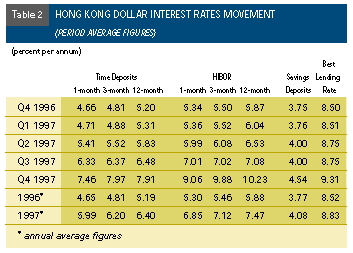
Growth of customer deposits slowed from 10.4% in 1996 to 8.4% in 1997. The slow-down, mainly evident in non-US dollar foreign currency deposits, reflected partly the valuation effect of exchange rate changes as the US dollar appreciated against most other major currencies. US dollar deposits on the other hand grew significantly by 17.1% during the year, after declining by 1.4% in 1996. This outstripped the growth in Hong Kong dollar deposits of 9.8% (19.5% in 1996). Despite the faster growth in US dollar deposits, the share of Hong Kong dollar deposits as a percentage of total deposits was 57.7% at the end of December 1997, still higher than the 57% at the end of 1996 (Chart 11).
Within Hong Kong dollar deposits, demand and savings deposits declined by 11.7% and 8.2% respectively in 1997 (Table 3). The decline was mainly due to a shift to time deposits as banks offered higher interest rates to attract Hong Kong dollar time deposits and as the demand for transaction balances slowed. Time deposits thus continued to grow at a rapid pace of 20.4% in 1997 (21.2% in 1996). Swap deposits, which had been on a declining trend since the partial deregulation of interest rates from October 1994, showed a modest increase.
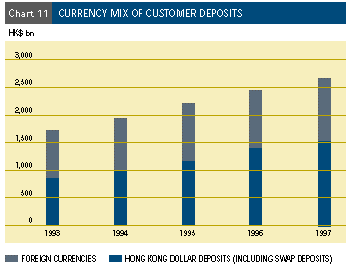
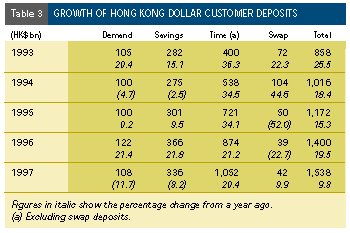
As in previous years, banks continued to raise medium to long-term funds through the issuance of negotiable certificates of deposit (NCDs). In line with the overall trend, interest rates of NCDs increased substantially in the last quarter. The share of Hong Kong dollar denominated NCDs rose from 73% at the end of 1996 to 78% at the end of 1997. Around 70% of the Hong Kong dollar denominated NCDs were held by authorized institutions, compared with 68% at the end of 1996.
ROBUST GROWTH IN DOMESTIC LENDING
Growth in total customer lending continued at a sluggish pace of 5.3% in 1997 (4.7% in 1996). This reflected a decline of 10.3% in off-shore lending brought about largely by the depreciation of the Yen.
Domestic loans grew at a strong pace of 24.5% in 1997, compared with 17% in 1996 (Charts 12 and 13). Robust growth in the property and security-related lending in the first nine months of the year mainly contributed to the increase. For 1997 as a whole, residential mortgage lending expanded by 29.9% (22.7% in 1996) and lending to property development and property investment grew by 37.6% (23.6% in 1996) and 30% (28.5% in 1996) respectively (Chart 14). However, growth in property lending slowed sharply in the last quarter of the year. While loans to stockbrokers grew modestly by 2% (61.4% in 1996), those to non-stockbroking companies and individuals for the purchase of shares increased by 56.8% (7% in 1996) due to active trading in the stock market.
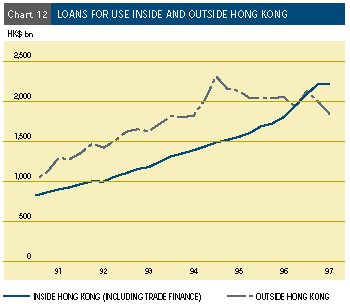
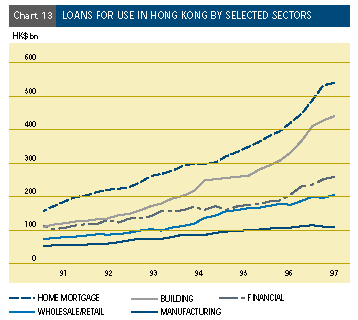
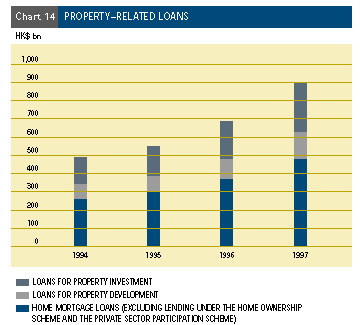
ANOTHER PROFITABLE YEAR FOR LOCAL BANKS
Local banks enjoyed reasonable profit growth in 1997, despite the less favourable conditions towards the end of the year. Pre-tax operating profits from their Hong Kong offices grew by 11.6% and post-tax profits by 9.8%. The corresponding increases in 1996 were 16% and 12.9% respectively.
The experience of the banking sector as a whole was however less favourable as branches and subsidiaries of foreign banks marked down the value of holdings of regional debt securities and increased their provisions against loans to regional borrowers. In addition, the rise in funding costs was reflected in only sluggish growth in net interest income.
Local banks fared rather better in this respect, thanks to the strong growth in domestic lending volumes in the first nine months of the year. This was however partly offset by a narrowing of the local banks?net interest income as a percentage of average total assets from 2.41% in 1996 to 2.26% in 1997 (Table 4). This was due not only to increased funding costs in the second half of the year but also to the squeeze on mortgage rates caused by fierce competition in the first half.
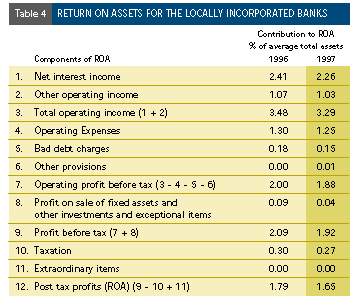
Total operating income was also boosted by healthy growth in non-interest income (for example, from fees and commission). Operating expenses, however, grew more rapidly than income by 15.1%, leading to a slight deterioration in the cost-income ratio, to 37.8%.
LOWER DOMESTIC BAD DEBT CHARGE
The local banks?bad debt charge in their domestic books as a percentage of average total assets fell from 0.18% in 1996 to 0.15%* in 1997 as the problems which had affected a number of listed companies in 1996 diminished.
The bad debt charge of the banking sector on the other hand rose although it still amounted to only a small proportion of average total assets, 0.12% (0.09% in 1996). This arose as a result of an increased charge on the regional exposures booked in Hong Kong by some foreign authorized institutions. The figure does not however include further provisions that were made against investments in regional debt securities.
IMPROVED DOMESTIC ASSET QUALITY
The ratio of classified loans (i.e. those rated substandard, doubtful or loss) of the local banks declined to 2.08% of total loans compared with 2.68% at end-1996 (Table 5). This reflected an improvement in domestic asset quality. Loans overdue for more than three months and rescheduled loans as a percentage of total loans similarly declined to 1.81% at the end of the year (Table 6). A number of foreign banks and deposit-taking subsidiaries however saw a deterioration in the quality of their regional exposures booked in Hong Kong.
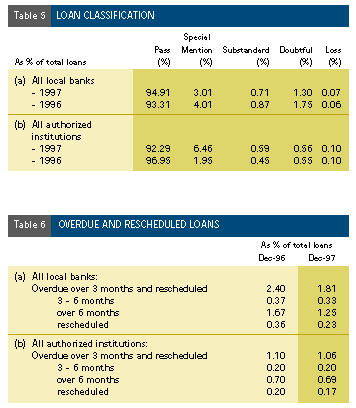
This was reflected in a sharp rise in those loans classified as "special mention" by the banking sector as a whole, from 1.95% to 6.46% of total loans as at the year end. The ratio of classified loans for the whole banking sector showed only a modest increase, to 1.25%, but can be expected to deteriorate in 1998 as more loans migrate into this category.
CREDIT CARD BUSINESS
Deterioration in credit card repayments is generally a first sign of deterioration in asset quality. The level of credit card receivables rose by 29.2% in 1997. Delinquent accounts as a percentage of total receivables however fell to 0.64% at end 1997 (0.87% at end 1996) and the charge-off ratio dropped to 2.1% for the year (2.3% in 1996) (Table 7). There was therefore no indication of a general deterioration in the quality of the credit card portfolios as at the end of 1997. Table 7 summarizes the results of the monthly credit card survey on 17 authorized institutions which are major participants in the credit card business.
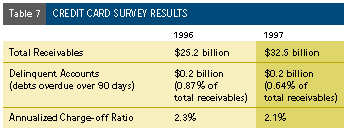
CAPITAL ADEQUACY REMAINED HIGH
As at the end of 1997, the consolidated capital adequacy ratio of locally incorporated institutions stood at 17.5%, down slightly from 17.8% as at the end of 1996. Nonetheless, this is still a high ratio by international standards. The capital adequacy regime was revised to incorporate market risk with effect from 31 December 1997. Locally incorporated institutions with insignificant market risk exposures were exempted under the de minimis criteria set out in the new regime. The adjusted capital adequacy ratio for the non-exempt institutions as at end-1997 was only slightly lower by 0.16% than their unadjusted position.
BANKING SECTOR - MORE CHALLENGES AHEAD
Banks are expected to face a tougher year in 1998 with slower growth in lending, narrowing of interest margins and potential rise in bad debts. However given that local banks are well capitalized, liquid and have good underlying profitability, they should be able to cope with such challenges. The regional crisis has emphasized again the importance of sound fundamentals in banking: strong capital and liquidity as well as prudent management of risks. Banks in Hong Kong have demonstrated that they are amongst the strongest in the region in these respects. But the lesson of the last few months is that no bank can afford to be complacent.